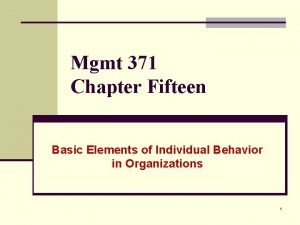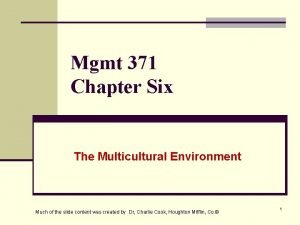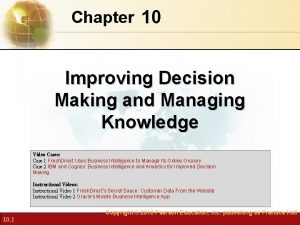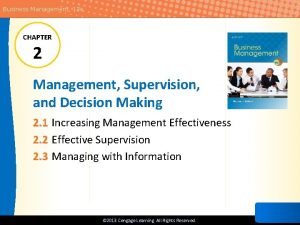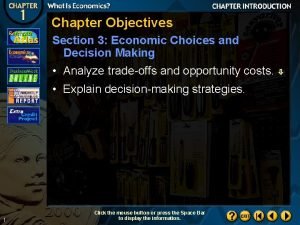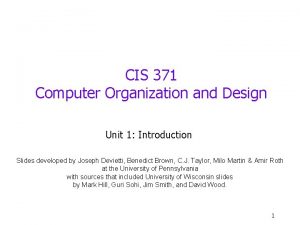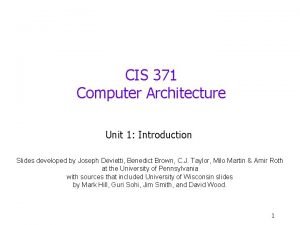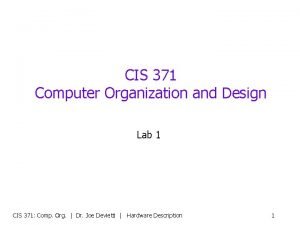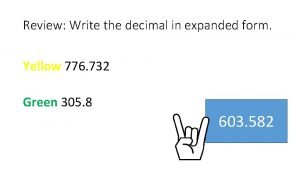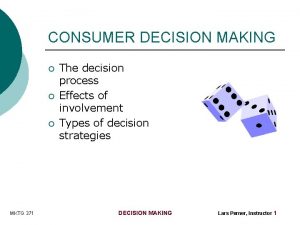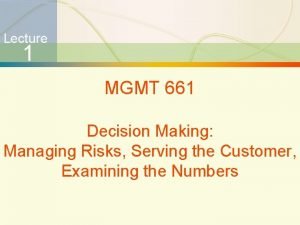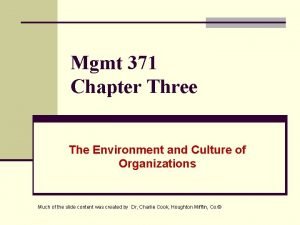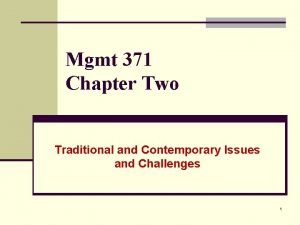Mgmt 371 Chapter Nine Managing Decision Making and





















- Slides: 21

Mgmt 371 Chapter Nine Managing Decision Making and Problem Solving Much of the slide content was created by Dr, Charlie Cook, Houghton Mifflin, Co. © 1

Types of Decisions: Programmed Decisions n Programmed Decisions - A decision that is a fairly structured decision or recurs with some frequency or both. n n n Matters of a routine nature that can be predicted, hence virtually automatic decisions can be made based on established rules and guidelines. Procedures n SOPs n Policies n Rules Examples n Processing drop/add slips destination. 2

Types of Decisions: Nonprogrammed Decisions n Nonprogrammed Decisions - A decision that is relatively unstructured and occurs much less often a programmed decision. n n n Developing solution for complex, unique, nonroutine problems Procedures n Creative problem-solving techniques n Brainstorming, GDSS, focus groups Examples: n New product development n Reengineering Processing drop/add slips Example: Choosing a vacation destination. 3

Decision-Making Conditions n Decision Making Under Certainty n The decision maker knows with reasonable certainty what the alternatives are and what conditions are associated with each alternative. n Decision Making Under Risk n The availability of each alternative and its potential payoffs and costs are all associated with risks. n Think probability. n Decision Making Under Uncertainty n The decision maker does not know all the alternatives, the risks associated with each, or the consequences of each alternative. 4

The Classical Model of Decision Making 5

The Rational Decision-Making Process Recognize & Define Decision Situation Identify Alternatives Evaluate Alternatives Select Best Alternative Implement the Chosen Alternative Evaluate Results 6

Recognizing Defining the Decision Situation n Problem Identification n Deviation from past performance. n Deviation from planned performance. n Outside criticism. n Avoid: Defining problems to meet preconceived solutions. n Identifying symptoms as problems. n Losing hands. n 7

Types of Problems n Opportunities n Crisis Problems n Routine Problems 8

Identify Alternatives n Managers develop several feasible alternative courses of action. n Too often managers get into a rut and fail to develop creative alternatives. n New perspectives and inputs from others may be beneficial. 9

Evaluate Alternatives n Considerations n Legality of the alternatives. n Ethicality (ethicalness) of the alternatives. n Economic feasibility of the alternatives. n Practicality of the alternatives. 10

Choosing Among Alternatives n The alternative which best fits the decision- maker’s situation given consideration of the risk or uncertainty is selected. n Assumes perfect and complete information is available to the decision-maker. 11

Evaluating the Results n All effective managers attempt to ensure that actual results meet planned results. n Strive to learn from both your successes and your mistakes. Determine why expected outcomes failed to materialize. n Develop guidelines for future decision making. n 12

Evaluating the Results Intended Outcome Actual Outcome Determine Cause of Deviation Corrective Action 13

Evaluating Alternatives in the Decision-making Process 14

The Administrative Model of Decision Making 15

Behavioral Aspects of Decision Making n Bounded Rationality n Decision makers are limited by their values and unconscious reflexes, skills, and habits. n n n Limitations to our ability to interpret and process information. Incomplete and imperfect information. Prevents optimal solutions. n Satisficing n The tendency to search for alternatives only until one is found that meets some minimum standard of sufficiency to resolve the problem. 16

Behavioral Aspects of Decision Making n Coalition n A positive or negative political force in decision making which consists of an informal alliance of individuals or groups formed to achieve common goals. n n Decisions are subject to internal politics/candidates/agendas. Decisions among members must be consistent with the coalition’s goals. 17

Illogical & Irrational Decision Processes n Intuition – an innate belief about something without conscious consideration. n Escalation of Commitment – staying with a decision even when it appears to be wrong usually because resources or reputations have been so heavily invested in its outcome. 18

Group and Team Decision Making in Organizations n Forms of Group Decision Making n Interacting group or team n Consists of an existing group or newly formed team interacting and then making a decision. n Nominal groups n Generating ideas through the individual contributions of alternatives that are winnowed down to reach a decision. n Delphi groups n Developing a consensus of expert opinion from a panel of experts who individually contribute through a moderator. n Panelists do not have direct contact. 19

Advantages of Group Decision Making n More information and knowledge are available. n More alternatives are likely to be generated. n More acceptance of the final decision is likely. n Enhanced communication of the decision may occur. n Better decisions are usually made. 20

The Dark Side of Group Decision Making n More time consuming than individual decsion making (more costly). n Groups can be dominated and manipulated by powerful individuals. n Groupthink may occur. n Compromises arising from indecision may occur. n Committees may dilute accountability. n Groups may take greater risks than individuals. 21
 Mgmt 371
Mgmt 371 Mgmt 371
Mgmt 371 Mgmt 371 final exam
Mgmt 371 final exam Improving decision making and managing knowledge
Improving decision making and managing knowledge No decision snap decision responsible decision
No decision snap decision responsible decision Dividend decision in financial management
Dividend decision in financial management Chapter 6 prices and decision making assessment answers
Chapter 6 prices and decision making assessment answers Five step decision making process
Five step decision making process Chapter 2 economic systems and decision making answer key
Chapter 2 economic systems and decision making answer key Management chapter 5 planning and decision making
Management chapter 5 planning and decision making Chapter 2 economic systems and decision making
Chapter 2 economic systems and decision making Chapter 2 economic systems and decision making
Chapter 2 economic systems and decision making Chapter 11 decision making and relevant information
Chapter 11 decision making and relevant information Chapter 2 management supervision and decision making
Chapter 2 management supervision and decision making Chapter 11 decision making and relevant information
Chapter 11 decision making and relevant information Options-based planning
Options-based planning Chapter 1 section 3 economic choices and decision making
Chapter 1 section 3 economic choices and decision making Cis 371
Cis 371 Cis 371
Cis 371 374 en yakın onluğa yuvarlama
374 en yakın onluğa yuvarlama Cis 371
Cis 371 284 371 in word form
284 371 in word form
